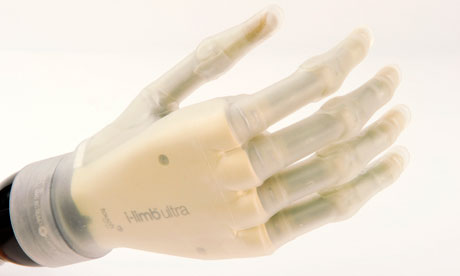Should medical aids discretely simulate normality – perhaps for society's comfort rather than the wearer's – or should they accentuate difference and express the wearer's identity? For Mullins, the discussion is no longer about compensating for a deficiency, but about augmenting the body. The same might be true of theSouth African Paralympian sprinter Oscar Pistorius. His carbon-fibre Cheetah running blades have made him such a threat that he was initially banned from competing against full-bodied athletes in the Beijing Olympics – he was allowed to compete in London, though, and has qualified for the 400m relay.
 Improving life … i-Limb ultra prosthetic hand. Photograph: Wellcome Images/Wellcome Library
Improving life … i-Limb ultra prosthetic hand. Photograph: Wellcome Images/Wellcome LibraryIf being human means being defined by our limits as much as by our abilities, we are reaching the stage where prosthetics and technological gizmos will challenge what we think should be possible. Professor Kevin Warwick tested that boundary when he implanted an RFID transmitter – basically a microchip that could switch on lights and open doors – into his body and called himself the first cyborg. Yet some would argue that anyone who carries a smartphone is effectively using a prosthesis – a pocket backup brain, an iLimb (there is actually something called an i-Limb in the show but it's a bionic hand, not a PDA). Presumably, when such technologies become more invasive we'll have reached what futurists call "the singularity", or the dissolving of the distinction between human and machine.
What the Superhuman exhibition does well is demonstrate how design and technology challenge our ethics and our attitudes to the body. But it's also one of those shows where the objects are merely illustrations of the issues, and the issues become broad indeed. In one of the video displays, the bioethicist Julian Savulescu argues that humans don't just need physical enhancement but moral supports too. He argues that the reason we can't rally together and tackle climate change – the biggest threat to the survival of the species – is that we evolved to look after our own tribes of about 150 people. Instead of sugar water, what we need is altruism in a can.



